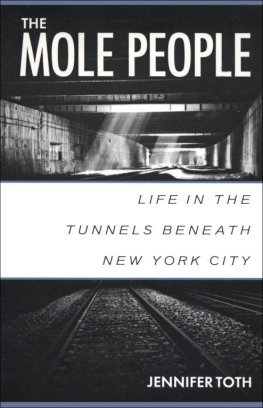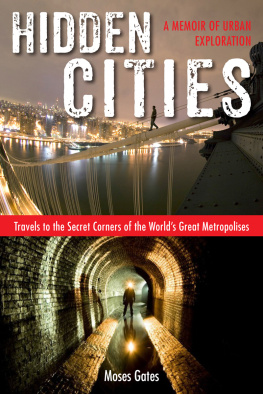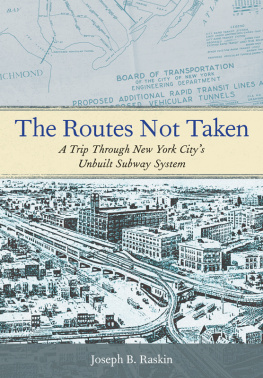Jennifer Toth
THE MOLE PEOPLE
LIFE IN THE TUNNELS BENEATH NEW YORK CITY
To my father who teaches by example and love
and
To Kristen, Dericka, Richard, Julie, and all the children in the tunnels in hope that they will carry the lesson with them
If you have built castles in the air, that is where they should be. Now put the foundations under them.
David Thoreau

I THOUGHT A GREAT DEAL ABOUT THE TITLE OF THIS BOOK. ALthough there are several communities of tunnel dwellers who call themselves the mole people, there are many individuals living in the tunnels who take issue with the term. In homeless circles aboveground, the tunnel people are commonly referred to as mole people. Sometimes the term is used in such circles disparagingly, to establish higher status within the homeless community.
Graffiti artist Chris Pape and photographer Margaret Morton each raised concerns about The Mole People because it is regarded as a pejorative term among homeless advocates, and more important to us all, it is insulting to some tunnel dwellers. Bernard Isaacs and his community under Riverside Park were those we most wanted to protect from this title. For years, Bernard has objected to the term because he feels it is a label that portrays him as an animal, not as a person. Yet when I talked to Bernard about the title of this book, he agreed The Mole People was the right choice.
I chose the title for several reasons. The people of New York City who live underground are most commonly known as mole people. And it is no accident that the term conjures freakish images. I hope this book will reverse the horrible and striking image of mole people simply by showing what I saw and found. I hope the stories from the tunnels will bring a better understanding of the underground people. By writing their stories, I hope to dismiss the myth of animal-like underground dwellers, so that you, the reader, can come to know that mole people dont exist beneath the surface of New York City, but people do.
MY TEN-YEAR-OLD FRIEND KRISTEN WAS THE FIRST TO TELL me about the mole people. She was one of my students when I volunteered in the Harlem tutorial program during my year of graduate school at Columbia University. We met every week. She taught me about street life in New York, while I helped her with multiplication tables.
One Saturday morning we sat together on a thick red couch in the plush hall of the International House at a great bay window overlooking Riverside Park. Outside the weather was cold but bright, and the sun reaching into the room made us warm and happy. Kristen, bored by her school work and hungry for attention, searched for distractions in the high ceilings, the polished piano, and the wall paintings.
I know this girl at school, Julie. She dont live like this. She live underground in a tunnel, Kristen announced. Her eyes grew wide and excited as they did when she began one of her tales. I laughed.
Really, its true! she insisted, straightening her slouched back. She live in one of them tunnels.
I asked if she were a friend of Julies.
No, she nobodys friend. She dirty all the time, and she be stinky too, Kristen shivered. Her eyes lit with a familiar smile that was never far from her. Then she added with a giggle, She be one of them mole people. She wiggled her fingers near her mouth to indicate whiskers, squinching up her nose and eyes to look like an imagined mole. She looked more like my cat than a rodent, however, and I laughed again and she laughed with me.
While I was dubious about her story, I asked her for more details about Julie, including the name of the school, and then Kristen arranged for me to meet Julie and her father at the swing set in Morningside Park on a Saturday morning. They found me and told their story, one of many to come on the following pages, but they refused to take me to their underground home.
I WAS UNEASY TALKING TO HOMELESS PEOPLE. ALTHOUGH I HAD served in soup kitchens in high school and college, coming from St. Louis, I found New York Citys homeless wild and frightening. They seemed to multiply three-fold on each corner during my 1989-90 year at Columbia and their squabbling over the same turf seemed threatening as I passed by. Then, too, young girls were attacking pedestrians in the area with needles and everyone was terrified that the tips were AIDS-infected.
However, two experiences made me less reluctant to talk to the homeless. My friend Robert Meitus, also at Columbia that year, had an extremely open manner with those we met on the street, even embracing them at times. He and his band sometimes gathered near midnight on the long white steps of Columbia Universitys administration building next to the schools statue and played for the homeless who gathered in the sweeping white moonlight. He wrote some songs for and about homeless individuals in the area. He broke my fear of a population that seemed untamed and dangerous. The other experience was more pointed. One night I was feeling upset as I left my room, and I saw a homeless woman with a shopping cart of trash bags filled with empty cans and old clothes. She asked me for money. I said I had none. She thanked me and smiled. Then, seeing my tears, she began giving me advice with a gentle look and soft eyes until at the end, she reached into one of her garbage bags and handed me a limp and fading white carnation. I, in turn, spoke to her as more than a something on the street asking for money. She had lost her apartment a few days earlier, her children were with friends, and she was combing the streets for cans and luck, she said.
After our talk, I became less afraid of approaching the homeless on the street and talking to them. The homeless on the streets near the university, while they had heard seemingly fantastic stories about mole people, had never met any.
The following summer I interned at The Los Angeles Times bureau in New York and continued the search. Many of the homeless in Grand Central Station, not far from my office, claimed they had seen mole people or even visited their communities. Several promised to take me up the tunnel tracks to them, but, to my relief, none came through. One of them, however, directed me to St. Agnes Soup Kitchen nearby, where I spoke with the director.
Ive heard some stories, he said at first. I havent been down there. Then he began to hedge. Im not saying there are such people, but Im not saying there arent, he smiled when pressed. Finally, as we walked out, he quietly suggested that I visit Sergeant Bryan Henry, the Metropolitan Transit Police officer in charge of homeless outreach in Grand Central Station.
Finding Sergeant Henrys small office was not easy, and when I did, another officer stood by when I explained that I wanted to write a story about the underground homeless. You mean the mole people, the two men laughed. No one is living underground, Henry said flatly, theyre just stories.
When the other officer left and I continued recounting the various tales I had picked up, Henry listened more seriously. When I said that some homeless men had offered to take me into the tunnels, he asked for their names. While I was telling him about conditions at different locations in the tunnels, as they had been told to me, a woman officer walked in. She looked stunned.
You told her about all that? she accused Henry. What is going on?
Henry looked from her to me, covered his face with his hands, and took his feet off his desk. He rose, ushered her out, and shut the door.
OK, he began. Im going to tell you about this. Its big. Theres a city beneath the streets







